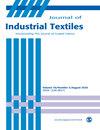Enhancement of mechanical and thermal properties of carbon fiber phenolic resin composites using silicon carbide filler for thermal protection system applications
IF 2
4区 工程技术
Q1 MATERIALS SCIENCE, TEXTILES
引用次数: 0
Abstract
Thermal protection systems (TPS) are vital for re-entry vehicles for their safe passage into the atmosphere from space. Hence, researchers took a keen interest in improving the thermal and ablative properties of composites to be used in making thermal protection systems. Therefore, an attempt was made to improve the thermal and ablative properties of composites made of carbon fibers (Cf) and resorcinol formaldehyde phenolic (Ph) resin with the incorporation of silicon carbide (SiC) particles. The filler was added in various percentages (0 wt% - blank, 1 wt%, 3 wt%, and 5 wt%), and the composites were tested for ablative, thermal and mechanical properties. The results demonstrate that the SiC-modified PAN-based carbon fiber reinforced phenolic (SiC-PANCf-Ph) composite with 3 wt% SiC enhancement exhibited ideal properties. The post-ablation phase composition and microstructure were examined through X-ray diffraction (XRD), Scanning electron microscopy (SEM), and energy-dispersive X-ray spectroscopy (EDS). The surface morphology evidences the formation of a silicon dioxide (SiO使用碳化硅填料提高热保护系统应用中碳纤维酚醛树脂复合材料的机械和热性能
热保护系统(TPS)对于重返大气层飞行器从太空安全进入大气层至关重要。因此,研究人员对改善用于制造热保护系统的复合材料的热性能和烧蚀性能产生了浓厚的兴趣。因此,研究人员尝试在碳纤维(Cf)和间苯二酚甲醛酚醛树脂(Ph)制成的复合材料中加入碳化硅(SiC)颗粒,以改善复合材料的热性能和烧蚀性能。填料的添加比例各不相同(0 wt% - 空白、1 wt%、3 wt% 和 5 wt%),并对复合材料进行了烧蚀、热和机械性能测试。结果表明,SiC 增强 3 wt% 的 SiC 改性 PAN 基碳纤维增强酚醛(SiC-PANCf-Ph)复合材料具有理想的性能。通过 X 射线衍射(XRD)、扫描电子显微镜(SEM)和能量色散 X 射线光谱(EDS)检测了烧结后的相组成和微观结构。表面形貌证明复合材料上形成了二氧化硅(SiO2)层。SiC-PANCf-Ph 复合材料的烧蚀率最低,增强了其有效应用于 TPS 的潜力。
本文章由计算机程序翻译,如有差异,请以英文原文为准。
求助全文
约1分钟内获得全文
求助全文
来源期刊

Journal of Industrial Textiles
MATERIALS SCIENCE, TEXTILES-
CiteScore
5.30
自引率
18.80%
发文量
165
审稿时长
2.3 months
期刊介绍:
The Journal of Industrial Textiles is the only peer reviewed journal devoted exclusively to technology, processing, methodology, modelling and applications in technical textiles, nonwovens, coated and laminated fabrics, textile composites and nanofibers.
 求助内容:
求助内容: 应助结果提醒方式:
应助结果提醒方式:


